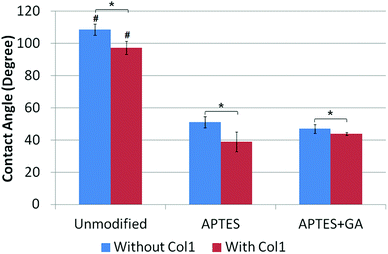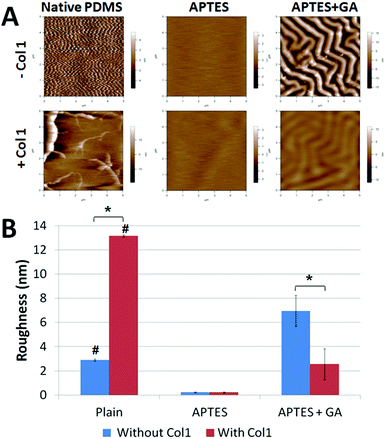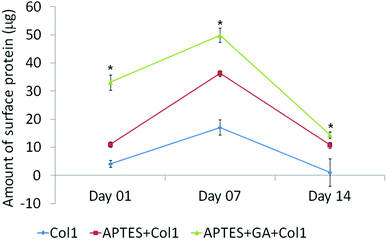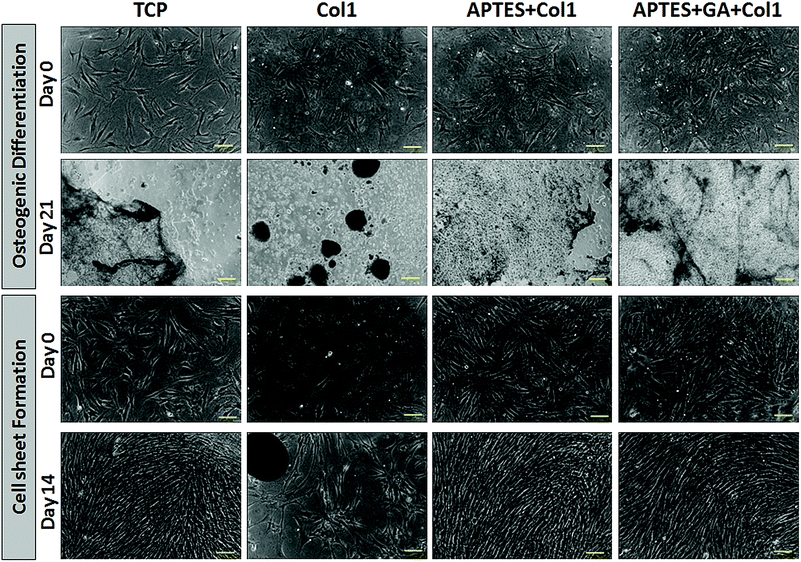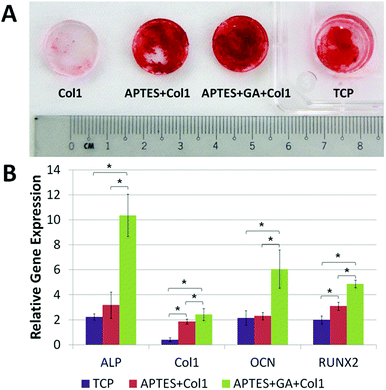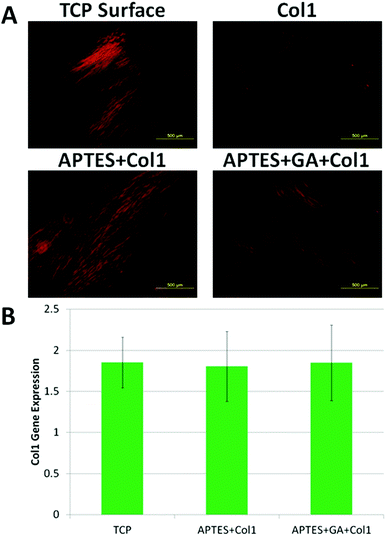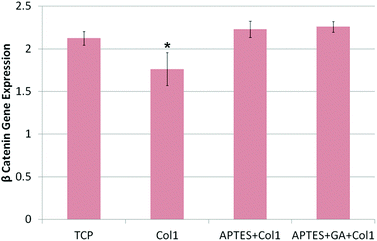The effects of poly(dimethylsiloxane) surface silanization on the mesenchymal stem cell fate
Yon Jin
Chuah†
a,
Shreyas
Kuddannaya†
b,
Min Hui Adeline
Lee
a,
Yilei
Zhang
*b and
Yuejun
Kang
*a
aSchool of Chemical and Biomedical Engineering, Nanyang Technological University, 62 Nanyang Drive, Singapore 637459, Singapore. E-mail: yuejun.kang@ntu.edu.sg; Tel: +65 6790 4702; Fax: +65 6794 7553
bSchool of Mechanical and Aerospace Engineering, Nanyang Technological University, 50 Nanyang Avenue, Singapore 639798, Singapore. E-mail: ylzhang@ntu.edu.sg; Tel: +65 6790 5952; Fax: +65 6792 4062
First published on 15th October 2014
Abstract
In recent years, poly(dimethylsiloxane) (PDMS)-based microfluidic devices have become very popular for on-chip cell investigation. Maintenance of mammalian cell adhesion on the substrate surface is crucial in determining the cell viability, proliferation and differentiation. However, the inherent hydrophobicity of PDMS is unfavourable for cell culture, causing cells to eventually dislodge from the surface. Although physically adsorbed matrix proteins can promote initial cell adhesion, this effect is usually short-lived. To address this critical issue, in this study, we employed (3-aminopropyl) triethoxy silane (APTES) and cross-linker glutaraldehyde (GA) chemistry to immobilize collagen type 1 (Col1) on PDMS. These modified surfaces are highly efficient to support the adhesion of mesenchymal stem cells (MSCs) with no deterioration of their potency. Significant changes of the native PDMS surface properties were observed with the proposed surface functionalization, and MSC adhesion was improved on PDMS surfaces modified with APTES + GA + Protein. Therefore, this covalent surface modification could generate a more biocompatible platform for stabilized cell adhesion. Furthermore, this modification method facilitated long-term cell attachment, which is favourable for successful induction of osteogenesis and cell sheet formation with an increased expression of osteogenic biomarkers and comparable extracellular matrix (ECM) constituent biomarkers, respectively. The surface silanization can be applied to PDMS-based microfluidic systems for long-term study of cellular development. Similar strategies could also be applied to several other substrate materials by appropriate combinations of self-assembled monolayers (SAMs) and ECM proteins.
Introduction
Poly(dimethylsiloxane) (PDMS) has been increasingly exploited to develop biological platforms or microfluidic devices for cell and tissue engineering applications due to the precision in controlling the micro-environment with minimal bio-reagent consumption and experimental costs.1 While several other biomaterials can be considered for similar fabrication purpose, PDMS is still widely utilized for rapid prototyping in the exploratory stages of fundamental research due to its versatility, transparency, gas permeability, low cost and ease of fabrication.2,3 However, the highly hydrophobic nature of PDMS often renders a non-biocompatible surface for long-term cell analysis.4–7 Although many have improved the bio-compatibility of PDMS by oxygen plasma treatment to improve the surface wettability or protein coating to enhance cell adhesion, these effects are often transient. For example, hydrophobic recovery is often observed on the plasma-treated PDMS surface depending on the time and temperature;8,9 and cell aggregation or clumping occurs on protein-coated PDMS when the cell population reaches confluence.4 These problems have limited the advancement of microfluidic technologies towards the development of microdevices for long-term cell studies. Therefore, there is a need for surface modification of the PDMS substrate to improve its bioaffinity for stabilized cell culture.Surface properties play a pivotal role in mediating stem cell behaviour, including adhesion, proliferation and differentiation.10–13 Modification of surface chemistry can potentially be applied to encourage stable and long-term cell attachment and facilitate an efficient cell–substrate interaction. It was found that silanization of PDMS could lead to the formation of a cross-linking self-assembled monolayer (SAM), which had proven to be an efficient strategy to stabilize the protein immobilization on PDMS in many studies.14–16 Inspired by these early studies, we had recently demonstrated that chemical modification with (3-aminopropyl)triethoxy silane (APTES) and glutaraldehyde (GA) could change the surface chemistry, wettability and protein binding affinity on the PDMS substrate.17 These changes had induced constructive and synergistic effects on cell adhesion, morphology, and proliferation of the mesenchymal stem cells (MSCs). While the chemical modification could enhance cell adhesion and proliferation in a short time frame, some important questions of this application related to tissue engineering remain unsolved. For example, it is still unclear if the chemical modification could stabilize the cell adhesion upon confluence, and how it could affect the potency of the adhered MSCs during a long-term culture.
One of the major applications of MSCs in regenerative medicine is the differentiation of stem cells towards the osteogenic lineage for further use in bone regeneration. Besides that, MSCs have been recently exploited to develop continuous cell sheets as an alternative strategy to benefit stem cell-based tissue engineering, such as blood vessels,18 cartilage,19 bone,20 and myocardial.21 To explore the effect of different cues (e.g. chemical, mechanical and growth factors) on the stem cell potency, long-term cell adhesion and stability for several weeks on the substrate surface are necessary for in vitro observation and analysis. Therefore, in this study, we performed PDMS surface silanization by APTES with/without GA, followed by protein immobilization using collagen type 1 (Col1), and evaluated the stability of the confluent cell layer and the potency of adhered MSCs for up to three weeks (Fig. 1).
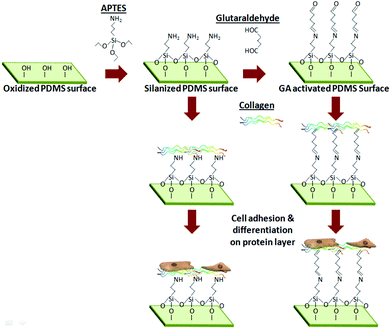 | ||
| Fig. 1 Schematic illustration of PDMS surface modification by APTES ± GA + Protein crosslinking and subsequent cell culture. | ||
Experimental
Silanization of PDMS
The protocol of PDMS silanization was adopted from a previous study.17 Specifically, ten parts of the silicone elastomer base and one part of the curing agent (SYLGARD®, Dow Corning, USA) were homogeneously mixed, cast into individual wells, and degassed for 30 min to remove air bubbles in a vacuum chamber. The degassed PDMS was then cured at 70 °C for 90 min. The crosslinked PDMS substrates were divided into three groups with their surfaces modified accordingly. Two groups of PDMS surfaces were plasma-treated for 3 min in a plasma cleaner (Harrick Plasma-PDC 32G, USA), incubated with 10% APTES (Sigma Aldrich, Singapore) for 2 h at 54 °C and washed twice with distilled water. Following that, one of the APTES-treated groups was further incubated with 2.5% GA (Sigma Aldrich, Singapore) solution for 1 h at room temperature, and then washed twice with distilled water. These procedures produced one unmodified group, one APTES-silanized group and one APTES + GA-silanized group. All the three groups were then immersed in 0.1 mg ml−1 of Col1 solution (Life Technologies, Singapore), and stored at 4 °C overnight before washing twice with distilled water. All PDMS substrates were exposed to UV sterilization for 60 min prior to cell seeding. Standard tissue culture plates (TCP) (Nunc, Singapore) were used as a control for the intended study.Surface characterization
The hydrophobicity of each PDMS surface was evaluated by measuring the water contact angle with a Theta Optical Tensiometer (Attension, Finland). Briefly, 5 μl of MilliQ water droplet with a resistivity >10 MΩ was brought into contact with different PDMS surfaces, and the contact angles were measured using a static sessile drop tangent method with the Drop Shape Analysis software. The contact angle was defined as the angle formed between the substrate surface and the tangent to the drop surface. At least 3 points of contacts were analyzed for each PDMS substrate.The surface roughness of the PDMS substrates was determined by atomic force microscopy (AFM, MFP-3D, Asylum Research, CA, USA) with a tapping mode AFM probe, which comprised a silicon tip with a radius of 28 ± 10 nm and the spring constant range of 0.5–4.4 N m−1. 20 μm × 20 μm topographical images were scanned at 0.8 Hz, a set point of 0.7 V and a resolution of 256 pixels. At least 3 points of contacts were analyzed for each PDMS substrate.
Stability of surface proteins
A micro-BCA Protein Assay Kit (Thermo Scientific, Singapore) was used to quantify the amount of proteins that were retained on different PDMS substrates at day 1, day 7 and day 14, respectively, after the surface modification. During each assay, the PDMS surfaces were incubated with 0.05 vol% Tween 20 (Sigma-Aldrich, Singapore) for 30 min on a shaker followed by washing twice with nuclease-free water to remove loosely bound or non-adherent protein molecules. The attached proteins were then determined according to the stated protocol in the Micro-BCA Protein Assay Kit, where the absorbance of specimens was measured at 562 nm with a Multiskan Spectrum microplate reader (Thermo Scientific, Singapore). For all the PDMS surfaces tested, the results were expressed as the amount of proteins retained on the surfaces.Cell culture
MSCs from porcine bone marrow aspirates were harvested and cultured according to the institutional guidelines of Nanyang Technological University. Under aseptic conditions, the bone marrow was aspirated from the iliac crest of porcine with an aspiration needle loaded with 3000 units of heparin. The bone marrow was then washed with 1 × PBS (1st Base, Singapore), and the bone marrow stromal cells were collected by centrifugation at 150g for 10 min. Following that, the collected cells were resuspended in Dulbecco's modified Eagle medium (DMEM) (Life Technologies, Singapore) supplemented with a 10% Fetal Bovine Serum (FBS) (Life Technologies, Singapore), penicillin (100 U ml−1) and streptomycin (100 μg ml−1) mixture (Life Technologies, Singapore) and 2 mM Glutamax™ (Life Technologies, Singapore) prior to seeding them into a culture flask, and cultured at 37 °C under a humidified atmosphere with 5% CO2. After 72 h, non-adherent cells were washed away, and the adhered MSCs were further expanded upon reaching confluence. Only MSCs of passages 2–4 were used for experiments.Osteogenic differentiation
6000 cells cm−2 were seeded to adhere on the substrate surfaces prior to osteogenesis. Induction of osteogenic differentiation in MSCs was initiated by introducing the osteogenic medium, comprising low glucose DMEM supplemented with 10% FBS, 50 μg ml−1 ascorbic acid, 1 mM sodium pyruvate, 100 U/100 μg penicillin/streptomycin, 1× glutamax, 10 mM β-glycerophosphate, and 10−7 M dexamethasone. The cells were then cultured under a humidified atmosphere with 5% CO2 and the differentiation medium was changed every 2–3 days. At least 3 specimens were collected for each individual analysis.Cell sheet formation
3 × 104 cells cm−2 were seeded to adhere on the substrate surfaces prior to cell sheet formation. MSC sheet formation was induced with low glucose DMEM supplemented with 50 μg ml−1 of ascorbic acid. The cells were then cultured under a humidified atmosphere with 5% CO2 and the differentiation medium was changed every 2–3 days. At least 3 specimens were collected for each individual analysis.Histological staining
Osteogenic cells (day 21) and cell sheets (day 14) were washed once with 1 × PBS before being fixed with 10% formalin overnight. Then the cells were washed with 1 × PBS before histological staining.To assess the osteogenic differentiation of MSCs on different modified surfaces, cells were immersed in Alizarin red solution for 5 min followed by gentle washing with distilled water until nonspecific staining was removed. On the other hand, MSC cell sheet formation on different modified surfaces was assessed by Picro Sirus red staining. Briefly, the cells were immersed in the Sircol Dye Reagent (Biocolor, County Antrim, United Kingdom) and washed twice with 0.05% glacial acetic acid (Merck Millipore, Singapore). The images of cells stained with Alizarin red were captured with a Canon 50D DSLR Camera (Canon, Singapore) while the cell sheets stained with Picro Sirius red were imaged with an Olympus IX71 inverted microscope equipped with polarizing lens (Olympus, Singapore).
Gene expression
The cell sheet and osteogenic cells were collected after 2 weeks. The total RNA was extracted with the RNeasy Kit (Qiagen, Singapore), and its concentration was quantified with a Nanodrop ND2000 (Thermo Scientific, Delaware, USA). 100 ng of total RNA was then reverse-transcribed to cDNA with an iScript™ cDNA synthesis kit (Biorad Laboratories, Singapore). A real time polymerase chain reaction (PCR) assay using the SYBR PCR Master Mix Kit (Life Technologies, Singapore) and StepOnePlus™ Real Time PCR Systems (Life Technologies, Singapore) were used to measure the mRNA expression level of osteogenic differentiation and MSC sheet associated gene markers. Primers used to amplify the reverse-transcribed cDNA are listed in Table 1. The primers for quantifying gene expression include osteocalcin (OCN) and alkaline phosphatase (ALP) for osteogenic differentiated cells, and Col1 and β-Catenin for cell sheet formation. Real-time PCR was initiated at 95 °C for 10 min, followed by 40-cycle amplification comprising a denaturation step at 95 °C for 15 s, and an extension step at 60 °C for 1 min. All data were normalized to the GAPDH mRNA level, and later expressed as the mRNA relative change with reference to the MSCs prior to differentiation using the Livak method.| Gene | Forward primer sequence (5′–3′) | Reverse primer sequence (5′–3′) |
|---|---|---|
| Collagen type 1 | CAGAACGGCCTCAGGTACCA | CAGATCACGTCATCGCACAAC |
| Alkaline phosphatase | ATGAGCTCAACCGGAACAA | GTGCCCATGGTCAATCCT |
| Osteocalcin | TCAACCCCGACTGCGACGAG | TTGGAGCAGCTGGGATGATGG |
| Runx2 | GAGGAACCGTTTCAGCTTACTG | CGTTAACCAATGGCACGAG |
| β-Catenin | TACCGTTGGATTGATTCG | GTCAGAGGTGCTGTGGCT |
| GADPH | GCTTTGCCCCGCGATCTAATGTTC | GCCAAATCCGTTCACTCCGACCTT |
Statistical analysis
The statistical significance between the two groups was determined by Student's t-test using the Minitab 16 Statistical Software (Minitab Inc., PA, USA). All experiments were performed at least thrice, and a p-value <0.5 was considered statistically significant.Results and discussion
In this study, the PDMS surface was silanized with APTES + GA or APTES only prior to Col1 immobilization (Fig. 1). The PDMS surface properties were then analyzed and their effect on the stability and potency of MSCs was evaluated.The surface wettability of the native PDMS as characterized by the water contact angle exhibited a hydrophobic surface property (108.63° ± 3.46°). Although Col1 adsorption resulted in a slight decrease of contact angle, the surface of PDMS + Col1 still remained hydrophobic (97.33° ± 4.00°). Surface silanization is known to significantly reduce the hydrophobicity of the PDMS surface,17 as confirmed in this study, showing that PDMS silanization by APTES with/without GA could reduce the contact angle to the hydrophilic region (<60°). Col1 protein adsorption on these chemically modified surfaces led to further reduction in the contact angle (<50°) (Fig. 2).
The unmodified PDMS exhibited a root-mean-square (RMS) roughness of 2.895 ± 0.085 nm, which increased notably to 13.17 ± 0.68 nm when coated with the Col1 protein (Fig. 3). The non-uniform substrate topography suggested protein aggregation on the unmodified PDMS surface. In contrast, the APTES-modified PDMS displayed the lowest roughness (0.229 ± 0.039 nm), and there was no significant difference before and after Col1 coating (0.2184 ± 0.01 nm). Meanwhile, additional cross-linking with GA after silanization resulted in higher roughness (6.952 ± 2.555 nm) with formation of evenly distributed nano-ridges. Coating of Col1 on the PDMS modified with APTES + GA further brought the roughness down to 2.555 ± 0.35 nm without evident protein aggregation.
Silanization of the PDMS surface with APTES with/without GA enables the formation of self-assembled monolayers of molecules with reactive functional groups (–NH2 or –COOH) and specific covalent binding with proteins.14,16 Effective matrix protein immobilization on the substrate is necessary to promote stable cell adhesion at the focal adhesion domains, thus aiding in long-term cell culture. The stability of the attached Col1 on the modified PDMS surfaces with APTES only or APTES + GA was investigated for up to 2 weeks. A higher amount of the surface bound Col1 was observed on the chemically modified PDMS as compared to the native PDMS (Fig. 4), which was attributed to the establishment of stable covalent linkages between the protein and the chemically modified PDMS surface. The relative increase of the surface bound protein at day 7 as compared to day 1 suggested a progressive increase in the strength of covalent linkages between the protein and substrates. However, as the incubation time reached day 14, the amount of the surface protein declined as compared to day 7, which could be due to the protein degradation under incubation conditions (37 °C and 5% CO2). Nevertheless, the chemically modified PDMS surface showed an improved surface protein immobilization and stability compared to the native PDMS.
The use of MSCs in osteogenic differentiation and cell sheet engineering is often investigated in vitro to improve MSC-mediated tissue regeneration. MSCs were cultured in two different culture media to induce osteogenesis and cell sheet formation, and their cell adhesion was monitored with a phase contrast microscope (Fig. 5). Initial cell seeding after 6 h was observed on all surfaces (day 0). However, total cell dissociation was observed as clumps of cell aggregation (dark spots in the 2nd column of Fig. 5) on unmodified PDMS surfaces, although with Col1 coating during both osteogenic differentiation (day 21) and cell sheet formation (day 14). The instability in cell adhesion on these native PDMS surfaces could be due to the hydrophobic recovery over time (Fig. 2) and the weakly bound matrix proteins (Fig. 4). In contrast, on the silanized surfaces with APTES and Col1 coating, minimal or no cell dissociation (Fig. 5) was observed in either osteogenic differentiation or cell sheet formation. It is known that a higher roughness profile could provide a higher surface area for the cell–substrate interaction and thus encourage cell adhesion and proliferation.22–27 Although the surface roughness was rather low on the chemically modified PDMS with APTES + Col1 (Fig. 3), the stability of confluent cell layer adhesion was significantly improved.
In addition, the PDMS surface modified with APTES + GA + Col1 exhibited a higher roughness profile (Fig. 3), improved surface wettability (Fig. 2), increased protein adsorption (Fig. 4), and thus further stabilized the cell adhesion at confluence with no observable incidents of cell dissociation (Fig. 5). As shown in our previous study, the surface silanization was able to enhance the proliferation of individual MSCs on the PDMS substrate.17 Compared to the conventional TCP, chemically modified PDMS surfaces provided a much more stable platform for long-term cell adhesion and proliferation. These results suggest that the behaviour of MSCs was not influenced by a single factor but rather by the interrelation of multiple contributing factors, i.e. the synergic effect of the surface functional group, improved surface wettability and higher protein adsorption.
The MSC–substrate interaction is crucial for osteogenic differentiation, and it is therefore important to evaluate the effect of specific surface chemistry for its suitability in long-term cell culture. For instance, numerous studies had demonstrated that enhanced osteogenic differentiation could be achieved by increasing the roughness profile of a substrate, reducing the surface hydrophobicity,28 providing functional groups that facilitate surface protein attachment29,30 and subjecting MSCs to nano-topographical cues.31
Chemically modified PDMS surfaces with APTES ± GA + Col1 present a hydrophilic surface (Fig. 2) with functional groups that facilitate better attachment of the Col1 protein (Fig. 4). As Col1 promotes the proliferation29 and osteogenesis of MSCs,29,30 the increased Col1 immobilization on APTES ± GA modified PDMS surfaces could enhance osteogenic differentiation. Furthermore, nano-ridge formation after treatment of APTES + GA + Col1 provided nano-topological cues (Fig. 3) that could possibly direct MSC differentiation towards osteogenic lineage.31 For further verification, osteogenic markers and bio-mineralization of osteogenic MSCs were assessed. The osteogenic lineage formation was demonstrated by Alizarin red staining, whereby the presence of brick-red nodules revealed the mineralization during osteogenic differentiation (Fig. 6A). Unmodified PDMS surfaces showed minimal staining while intense staining was observed on both chemically modified surfaces. Meanwhile, the osteogenic lineage on the TCP surface showed a weaker staining as compared to the modified PDMS surfaces. These results indicated that silanized PDMS surfaces were capable of enhancing mineralization than the conventional TCP surfaces (Fig. 6A) yet stabilizing the MSC adhesion. As common osteogenic biomarkers, alkaline phosphatase (ALP), osteocalcin (OCN), Col1 and Runx2 were used to quantitatively assess the effects of chemical modifications on osteogenesis. The data showed that osteogenic MSCs on PDMS surfaces modified with APTES + GA + Col1 exhibited significantly higher expression of all four osteogenic biomarkers as compared to the other two surfaces, including TCP (Fig. 6B). Gene expression could not be evaluated for the cells grown on unmodified PDMS owing to cell aggregation and dissociation at the point of analysis (Fig. 5).
The formation of an intact cell sheet relies on the cell–cell interaction and also on the presence of active ECM constituents, which supply the mechanical and chemical signals to mediate the cellular physiology and provide physical support for tissue development.32 In this study, the MSC cell sheet formation was characterized by Picro Sirus Red staining (Fig. 7A). It was observed that collagen fibers could not be formed on the unmodified PDMS surface, which could be attributed to the MSC dissociation and aggregation after 2 weeks of culture. On the other hand, the stability of MSC adhesion on the silanized PDMS surfaces allowed the formation of cell sheets as revealed by the prominent and bright red images under the polarizing microscope. The presence of collagen fibres was further verified by the quantitative analysis of Col1 gene expression, which showed similar profiles on the silanized PDMS surfaces as compared to TCP (Fig. 7B).
β-Catenin is a protein within the cells that is responsible for the regulation of cell growth and cell–cell adhesion.33 Gene expression of β-Catenin was evaluated during the early stage of MSC sheet formation (1 week) where minimal cell dissociation was observed on the unmodified PDMS surface, making it possible to evaluate the gene expression of β-Catenin. Compared to the unmodified PDMS, a significant increase in the gene expression of β-Catenin on silanized PDMS surfaces (Fig. 8) may eventually lead to higher protein level of β-Catenin, which could enhance the cell–cell adhesion to maintain the integrity of the formed MSC sheet. While compared with TCP surfaces, MSC sheet formation was achievable on chemically modified PDMS surfaces without deterioration in Col1 and β-Catenin expression. However, the subcellular localization of β-Catenin under the effect of surface silanization is still unclear in this study. It is well known that β-catenin plays a key role in cell adhesion and proliferation, and is regulated by multiple signalling pathways during stem cell development and tumorigenesis.34 Further studies on β-catenin localization in MSCs would be helpful to understand how the extracellular microenvironment affects stem cell biochemical signalling pathways through the cell–surface interaction.
In summary, silanization with APTES ± GA changes the surface chemistry of PDMS, which becomes more hydrophilic thereby enhancing Col1 protein attachment. Although the roughness profile varies between the two types of silanized surfaces, the interrelation with other surface properties further improved the stability of the confluence cell adhesion while maintaining both the potency of the MSCs and cell sheet formation.
Conclusions
Long-term cellular studies in PDMS-based microfluidic analytical devices are usually limited due to the inherent hydrophobicity and poor bioaffinity of the native PDMS surface. This study has shown that silanization by APTES ± GA cross-linking can profoundly change PDMS surface properties, including reduction of hydrophobicity, increased protein immobilization, and variation of nanotopography. The synergetic effect of these changes can be utilized to support the stability of confluent MSC culture, while retaining their osteogenic potency and supporting cell sheet formation. We believe that this surface functioning strategy can benefit future studies using PDMS micro-devices for long-term cell development on a chip.Conflict of interest
The authors declare no competing financial interest.Acknowledgements
Y. K. acknowledges the Tier 2 Academic Research Fund from the Singapore Ministry of Education (ARC 22/13). Y. Z. acknowledges the start-up research grant from the Nanyang Technological University, and the Tier 1 Academic Research Funds from the Singapore Ministry of Education (RGT 30/13 and RGC 6/13).Notes and references
- A. L. Paguirigan and D. J. Beebe, Bioessays, 2008, 30, 811 CrossRef CAS PubMed.
- J. M. K. Ng, I. Gitlin, A. D. Stroock and G. M. Whitesides, Electrophoresis, 2002, 23, 3461–3473 CrossRef CAS.
- S. K. Sia and G. M. Whitesides, Electrophoresis, 2003, 24, 3563–3576 CrossRef CAS PubMed.
- J. N. Lee, X. Jiang, D. Ryan and G. M. Whitesides, Langmuir, 2004, 20, 11684–11691 CrossRef CAS PubMed.
- D. Fuard, T. T. Chevolleau, S. Decossas, P. Tracqui and P. Schiavone, Microelectron. Eng., 2008, 85, 1289–1293 CrossRef CAS PubMed.
- J. C. McDonald, D. C. Duffy, J. R. Anderson, D. T. Chiu, H. Wu, O. J. A. Schueller and G. M. Whitesides, Electrophoresis, 2000, 21, 27–40 CrossRef CAS.
- D. C. Duffy, J. C. McDonald, J. A. Schueller and G. M. Whitesides, Anal. Chem., 1998, 70, 4974–4984 CrossRef CAS PubMed.
- D. Bodas and C. Khan-Malek, Sens. Actuators, B, 2007, 123, 368–373 CrossRef CAS PubMed.
- H. Hillborg and U. W. Gedde, Polymer, 1998, 39, 1991–1998 CrossRef CAS.
- A. J. Engler, S. Sen, H. L. Sweeney and D. E. Discher, Cell, 2006, 126, 677–689 CrossRef CAS PubMed.
- M. Kassem, Ann. N. Y. Acad. Sci., 2006, 1067, 436–442 CrossRef CAS PubMed.
- J. Protivínský, M. Appleford, J. Strnad, A. Helebrant and J. L. Ong, Int. J. Oral Maxillofac. Implants, 2007, 22, 542–550 Search PubMed.
- S. Lavenus, J. C. Ricquier, G. Louarn and P. Layrolle, Nanomedicine, 2010, 5, 937–947 CrossRef CAS PubMed.
- H. Yuan, W. M. Mullett and J. Pawliszyn, Analyst, 2001, 126, 1456–1461 RSC.
- C. M. Halliwell and A. E. G. Cass, Anal. Chem., 2001, 73, 2476–2483 CrossRef CAS.
- Z. H. Wang and G. J. Jin, Immunol. Methods, 2004, 285, 237–243 CrossRef CAS PubMed.
- S. Kuddannaya, Y. J. Chuah, M. H. A. Lee, N. V. Menon, Y. Kang and Y. Zhang, ACS Appl. Mater. Interfaces, 2013, 5, 9777–9784 CAS.
- M. Ishii, R. Shibata, Y. Numaguchi, T. Kito, H. Suzuki, K. Shimizu, A. Ito, H. Honda and T. Murohara, Arterioscler., Thromb., Vasc. Biol., 2011, 31, 2210–2215 CrossRef CAS PubMed.
- Y. Qi, Y. Du, W. Li, X. Dai, T. Zhao and W. Yan, Knee Surg. Sports Traumatol. Arthrosc., 2014, 22, 1424–1433 CrossRef PubMed.
- Y. Qi, T. Zhao, W. Yan, K. Xu, Z. Shi and J. Wang, Cytotherapy, 2013, 15, 44–56 CrossRef CAS PubMed.
- M. Augustin, M. A. A. Mahar, P. Lakkisto, I. Tikkanen, A. Vento, T. Pätilä and A. Harjula, J. Tissue Eng. Regen. Med., 2013, 7, 742–750 CrossRef CAS.
- E. Biazar, M. Heidari, A. Asefnezhad and N. Montazeri, Int. J. Nanomedicine, 2011, 6, 631–639 CrossRef CAS PubMed.
- S. Patntirapong, W. Singhatanadgit, P. Meesap, T. Theerathanagorn, M. Toso and W. Janvikul, J. Biomed. Mater. Res., Part A, 2014 DOI:10.1002/jbm.a.35214.
- A. F. Recum, C. E. Shannon, C. E. Cannon, K. J. Long, T. G. Kooten and J. Meyle, Tissue Eng., 1996, 2, 241–253 CrossRef CAS PubMed.
- K. Hatano, H. Inoue, T. Kojo, T. Matsunaga, T. Tsujisawa, C. Uchiyama and Y. Uchida, Bone, 1999, 25, 439–445 CrossRef CAS.
- T. W. Chung, D. Z. Liu, S. Y. Wang and S. S. Wang, Biomaterials, 2003, 24, 4655–4661 CrossRef CAS.
- K. Kieswetter, Z. Schwartz, D. D. Dean and B. D. Boyan, Crit. Rev. Oral Biol. Med., 1996, 7, 329–345 CAS.
- S. Anil, P. S. Anand, H. Alghamdi and J. A. Jansen, in Implant dentistry—a rapidly evolving practice, ed. I. Turkyilmaz, InTech, Europe, 2011 DOI:10.5772/16475. Available from: http://www.intechopen.com/books/implant-dentistry-a-rapidly-evolving-practice/dental-implant-surface-enhancement-and-osseointegration.
- K. S. Tsai, S. Y. Kao, C. Y. Wang, Y. J. Wang, J. P. Wang and S. C. Hung, J. Biomed. Mater. Res., Part A, 2010, 94, 673–682 Search PubMed.
- S. Mathews, R. Bhondea, P. K. Gupta and S. Totey, Biochem. Biophys. Res. Commun., 2011, 414, 270–276 CrossRef CAS PubMed.
- J. Kim, H. N. Kim, K. T. Lim, Y. Kim, H. Seonwoo, S. H. Park, H. J. Lim, D. H. Kim, K. Y. Suh, P. H. Choung, Y. H. Choung and J. H. Chung, Sci. Rep., 2013, 3, 3552 Search PubMed.
- C. M. Nelson and M. J. Bissell, Annu. Rev. Cell Dev. Biol., 2006, 22, 287–309 CrossRef CAS PubMed.
- F. H. Brembeck, M. Rosário and W. Birchmeier, Curr. Opin. Genet. Dev., 2006, 16, 51–59 CrossRef CAS PubMed.
- N. Barker and M. van den Born, Methods Mol. Biol., 2008, 468, 91–98 CAS.
Footnote |
| † These authors contributed equally to this work. |
| This journal is © The Royal Society of Chemistry 2015 |

